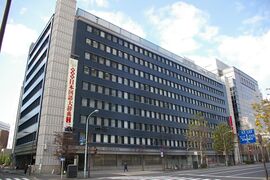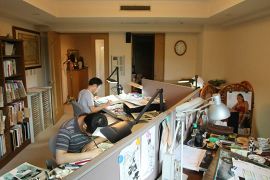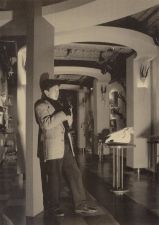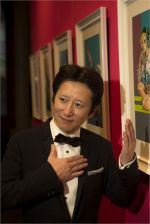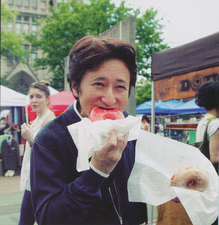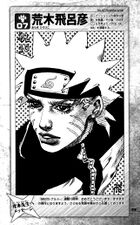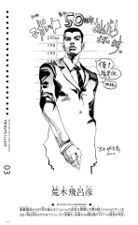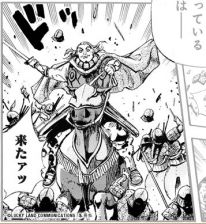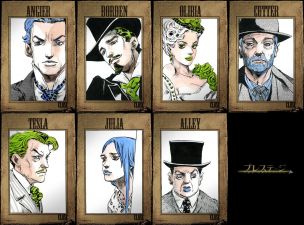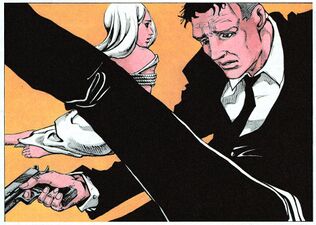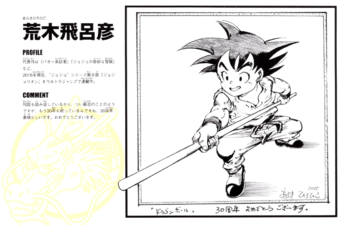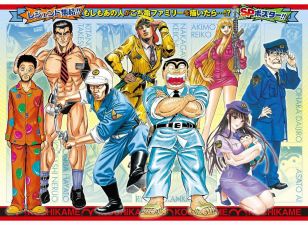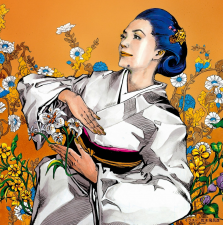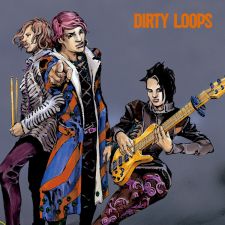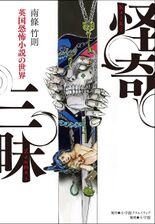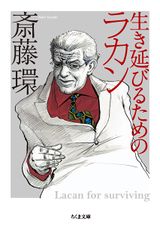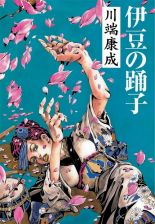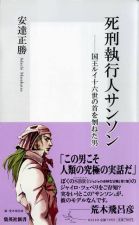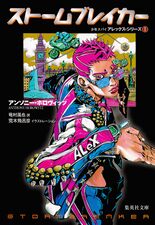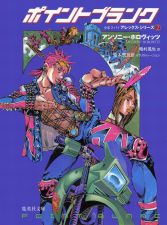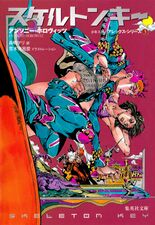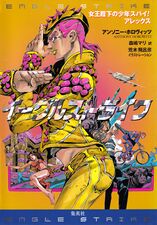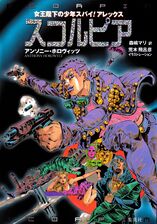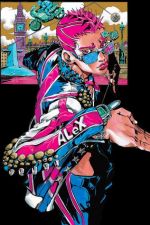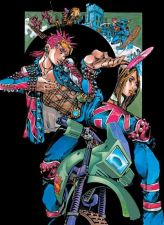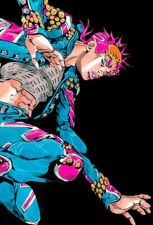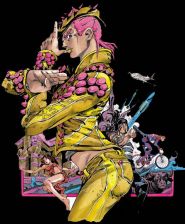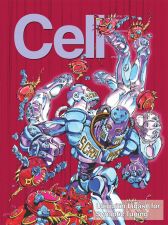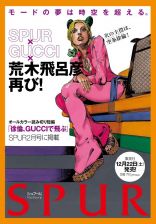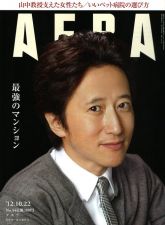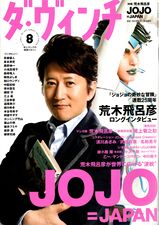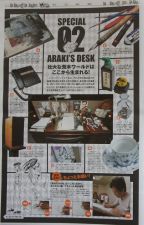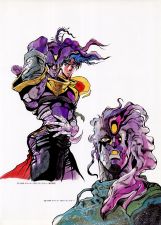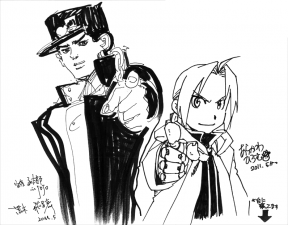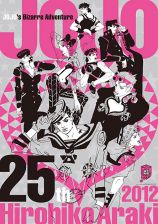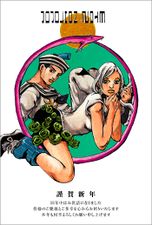Hirohiko Araki
Hirohiko Araki (荒木 飛呂彦, Araki Hirohiko) is a mangaka and author of JoJo's Bizarre Adventure, on which this wikia project is based. He made his debut under the name Toshiyuki Araki (荒木 利之, Araki Toshiyuki) in 1980 with his one-shot Poker Under Arms, and began his professional career with the short series Cool Shock B.T., Baoh, and The Gorgeous Irene.
Works
Manga
- Poker Under Arms (武装ポーカー, Busō Pōkā, 1980)
- Outlaw Man (アウトロー・マン, Autorō Man, 1981)
- Say Hello to Virginia (バージニアによろしく, Bājinia ni Yoroshiku, 1982)
- B.T. "the Wicked Boy" (魔少年ビーティー, Mashōnen Bī Tī, October 23, 1982)
- Cool Shock B.T. (魔少年ビーティー, Mashōnen Bī Tī, September 20, 1983–November 22, 1983)
- Baoh: The Visitor (バオー来訪者, Baō Raihōsha, October 9, 1984 – February 12, 1985)
- Gorgeous Irene (ゴージャス☆アイリン, Gōjasu Airin, 1985–1986)
- JoJo's Bizarre Adventure (December 2, 1986–ongoing)
- The Lives of Eccentrics (変人偏屈列伝, Henjin Henkutsu Retsuden, 1989–2003)
- Under Execution Under Jailbreak (死刑執行中脱獄進行中, Shikei Shikkōchū Datsugoku Shinkōchū, December 28, 1994)
- Dolce and His Master (ドルチ ~ダイ・ハード・ザ・キャット~, Doruchi Dai Hādo Za Kyatto, 1996)
- Thus Spoke Rohan Kishibe (岸辺露伴は動かない, Kishibe Rohan wa Ugokanai, June 24, 1997–December 4, 2015)
- Dead Man's Questions (デッドマンズQ, Deddomanzu Kuesuchonzu, June 2, 1999–July 7, 1999)
- Oingo Boingo Brothers Adventure (オインゴとボインゴ兄弟 大冒険, Oingo to Boingo Kyōdai Daibōken, October 23, 2002)
- Rohan at the Louvre (岸辺露伴 ルーヴルへ行く, Kishibe Rohan Rūvuru e Iku, April 8, 2010)
- Rohan Kishibe meets Gucci (岸辺露伴 グッチへ行く, Kishibe Rohan Gutchi e Iku, August 23, 2011)
- Jolyne, Fly High with GUCCI (徐倫、GUCCIで飛ぶ, Jorīn, Gutchi de Tobu, December 22, 2012)
Other
- Famicom Jump II: Saikyo no Shichinin (February 1991, seventh boss monster design)
- Kamedas (1993, an alternate story of Kochira Katsushika-ku Kameari Kōen-mae Hashutsujo, an illustration)
- JoJo's Bizarre Adventure (novel) (November 4, 1993, novel written by Mayori Sekijima and Hiroshi Yamaguchi, illustrated by Araki)
- JoJo 6251 (December 10, 1993, art and guidebook)
- JOJO A-GO!GO! (February 25, 2000, artbook)
- Music is the Key of Life (December 13, 2000, album by Sugiurumn, cover)
- GioGio's Bizarre Adventure 2: Golden Heart, Golden Ring (May 28, 2001, novel written by Gichi Ōtsuka and Tarō Miyashō, supervised and illustrated by Araki)
- Life Ground Music (February 27, 2002, album by Sugiurumn, cover)
- Alex Rider Series (女王陛下の少年スパイ!アレックス) (2002-2007, cover)
- Stormbreaker (novel, illustrations for Fantasy Press)
- Kochira Katsushika-ku Kameari Kōen-mae Hashutsujo (2006, 30th anniversary special illustration)
- "Catwalk" (April 26, 2006, single by SOUL'd OUT, cover)
- Uniqlo (2006, T-shirt design)
- Fist of the North Star (2006, special tribute illustration in Weekly Comic Bunch)
- Cell (September 7, 2007, front cover)
- The Book: JoJo's Bizarre Adventure 4th Another Day (November 26, 2007, novel written by Otsuichi, supervised and illustrated by Arashi)
- The Dancing Girl of Izu (2008, cover)
- "Breeeeze Girl" (June 24, 2009, a single by Base Ball Bear, cover of the limited edition)
- Naruto (2009, 10th anniversary special illustration)
- Hirohiko Araki's Super-Favorites! Rules of Movies (荒木飛呂彦の超偏愛! 映画の掟, "Araki Hirohiko no chō hen'ai! Eiga no okite", May 17, 2011)
- Hirohiko Araki's Bizarre Horror Movie Analysis (荒木飛呂彦の奇妙なホラー映画論, "Araki Hirohiko no Kimyō na Hora Eiga Ron", June 17, 2011)
- Shameless Purple Haze: Purple Haze Feedback (September 16, 2011, novel written by Kouhei Kadono, illustrated by Araki)
- JoJo's Bizarre Adventure Over Heaven (December 16, 2011, novel written by Nisio Isin, cover)
- Jorge Joestar (September 19, 2012, novel written by Ōtarō Maijō, illustrated by Araki)
- X -Cross- (September 19, 2012, an album by Sayuri Ishikawa, cover)
- HIROHIKO ARAKI WORKS 1981-2012 (2012, artbook)
- JOJOmenon (October 5, 2012, artbook)
- JOJOVELLER (September 19, 2013, artbook set)
- JoJonium (December 4, 2013 - March 4, 2015, covers of the large format re-release of JoJo's Bizarre Adventure)
- Main Themes (February 25, 2015, an album by Akira Senju, cover)
- Hirohiko Araki's Manga Technique (荒木飛呂彦の漫画術, "Araki Hirohiko no Manga Jutsu", April 17, 2015)
JoJo's Bizarre Adventure
Published in Weekly Shonen Jump between 1987 and 2004 and from 2004 to the present in Ultra Jump, JoJo's Bizarre Adventure represents Hirohiko Araki's primary brand and body of work.
The dust jacket of every volume of JoJo contains a note to the reader; a relatively great source of Araki's direct opinions.
Biography
The following information was compiled from a lecture Hirohiko Araki gave at Tokai Junior & High School in Nagoya City, Aichi Prefecture, as part of their Saturday Program series, as transcribed/compiled by @JOJO, Japan's premier site for JoJo-related news.
In his youth, Araki lived with his father, an office worker; his mother, a homemaker; and his two younger identical twin sisters.
Growing up, Araki assumed that he lived in a house without any snacks. In reality, his sisters would often eat all the snacks located in the house before he got home from school. Even when there were three snacks, one for each of them, the sisters would usually eat them all and proceed to conceal all evidence of having done so. When these doings came to light, a fight would erupt; and an event of this sort might occur on a daily basis. Araki would often feel such a sense of exclusion and ill-will towards his sisters that at times he felt averse to going home. He used to find relief in spending time alone in his room, reading classic manga from the '70s and his father's collection of art books, which Araki assumes informed his motive for drawing manga.
Araki drew his very first manga while he was in 4th grade. He attended a prep school through junior high and high school, which was where a friend complimented him on a manga he drew for the first time. Araki thought that if his very first fan thought he was good, he might want to become a manga artist. So, he began to draw manga in secret of his parents.
He began submitting work to publishers during his first year of high school; however, all of his submissions were rejected. At the same time, others artists who were around his age continued to make big splashes with their debuts (Ex: Yudetamago, Masakazu Katsura). Araki could not understand why he was being rejected, so he decided to finish off a submission on an all-nighter, go on a 4-hour trip to pay a visit to the editors in Tokyo, and ask them for an explanation.
At first he intended to visit Shogakukan, which published Shonen Sunday, but he was intimidated by the size of their building, and decided to take his submission into the smaller Shueisha (Publishers of Weekly Shonen Jump) building next door. It was noon when he visited, but one rookie editor (about 6'2", or 185 cm, tall) happened to be there, so he showed him his work. The editor, after reading the first page, promptly quipped "your white-out's leaked (You haven't fixed it)": he was criticized every time the editor flipped through each page. Araki, exhausted from having been up all night, felt like he was going to pass out. However, after he was finished, he was told that it might be good, and was immediately told to fix it up for the Tezuka Awards in 5 days. That submission was "Poker Under Arms", which won the runner up prize at the Tezuka Awards.Style and Influences
Araki's drawing commonly involves idealized figures in broad, expressive poses at adventurous scales and angles; with sharply inked lines and scattered, blackened planes; lending them a sculptural effect. In color illustrations and pages, Araki varies roughly complementary color juxtapositions.In terms of cartooning, a comparison can be drawn between Phantom Blood, Battle Tendency and Stardust Crusaders (1987 - '92) and the hypermasculine (and highly dimorphic) anatomical ideals applied by Tetsuo Hara in Fist of the North Star, and referenced by Araki in relation to action heroes of the 1980s.[3] Diamond is Unbreakable ('92 - '96) marks a transition to a more intersexual model; while Steel Ball Run (2004 - '11) sees greater realism, along with further incorporation of ideals of beauty consistent with the mode in fashion design.
Reference to illustrations by artists including Antonio Lopez and Tony Viramontes informs a number of individual illustrations and character poses in Araki's work from 1987 - 1992; decreasing from then along with increased use of photographic references.[4] Limited examples of costumes borrowed from contemporary fashion design have been identified.
As a film fan, In the 1980s Araki noted the popularity of action movies and the muscular physiques characteristic of their stars (such as Arnold Schwarzenegger and Sylvester Stallone). By this example, Araki would ponder; "Who is the strongest person in the world?". Subjects such as immortality and justice occurred to him as things that humans innately value and seek. Araki had also been on a trip to Italy two years prior to the creation of Part I: Phantom Blood, where he identified the exaltation of overt human beauty characteristic of renaissance art. Araki would combine these examples in the formulation of the basic plot and visual style of Phantom Blood.[3]
Araki has named Paul Gauguin and his approach to color theory as an influence.[5]
Araki has described his drawing method as "classical".[3] He has indicated admiration for Leonardo da Vinci in the text of the manga and otherwise; and in a video feature in JOJOVELLER, he is seen making visual reference to a book of Michelangelo's work[6] during the construction of a piece.
Manga that Araki has named as admirable or having had particular influence on him include Ai to Makoto by Ikki Kajiwara and Takumi Nagayasu, the most significant of his youth;[7] Ore wa Teppei by Tetsuya Chiba, which inspired him while in middle school to join the kendo club;[7] and Babel II by Mitsuteru Yokoyama, particularly influential for the concept of combat defined by special rules or laws.[3]
Araki has authored a book on the subject of Horror film and its influence on his work.
Araki has described his habit of naming characters and Stands after musicians and their works as "a simple hobby", and has indicated a strong preference for Western popular music.
Trivia
- Hirohiko Araki was born on June 7, 1960 in Sendai, Japan.
- Araki left before graduation from Miyagi University of Education.
- Araki's favorite book as a kid was The Adventures of Sherlock Holmes.[2]
- JoJo's Bizarre Adventure is Araki's most well-known work, published in Weekly Shonen Jump from 1987 to 2003, transferring to the seinen magazine Ultra Jump in 2004.
- Araki's Buso Poker was a "Selected Work" at the Tezuka Award in 1980.[8]
- In 2012, Araki celebrated his 30th year as a manga artist and the 25th anniversary of JoJo’s Bizarre Adventure.
Gallery
Artist Photos
Tributes
Album Covers
Novels
Magazines
Other
References
- ↑ Interview with Shoko Nakagawa, 2007
- ↑ 2.0 2.1 2.2 2.3 Weekly Shonen 「」 (JOJO冒險 荒木飛呂彥100問專訪); April 5, 2003
- ↑ 3.0 3.1 3.2 3.3 Phantom Blood PS2 release interview, 2006
- ↑ http://www30.atwiki.jp/ichi-1/pages/12.html
- ↑ Tokai High School lecture 2006, part 2
- ↑ Michelangelo – Tuttle le Opere – Edizione Riserveta ai Musei e Gallerie Pontificie, ISBN 9788872040256
- ↑ 7.0 7.1 Tokai High School lecture 2006, part 3
- ↑ Tokai High School lecture 2006, part 1
External links
- Tokai High School lecture, 2006, translated by Neuroretardant for ComiPress
